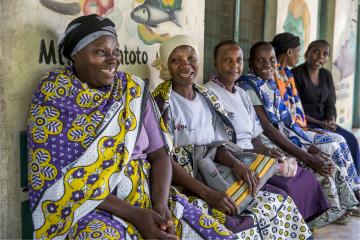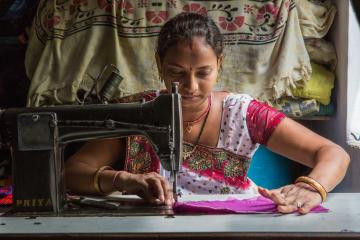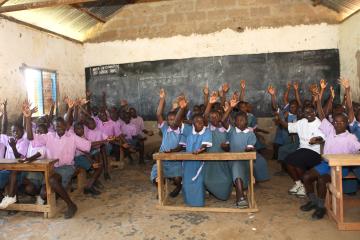
The importance of evidence in promoting the economic agency of women in Central America and Mexico

Globally, women are less likely than men to participate in the labor market (47 percent vs. 72 percent, respectively, as of 2022). In some Latin American countries, such as Guatemala, Honduras, El Salvador, and Mexico, participation rates are less than 45 percent. This translates to countless missed opportunities for women to gain income, empowerment, and economic agency.
Randomized evaluations can provide important lessons about design features that promote women's empowerment and labor force participation, and help us understand the process of women’s empowerment itself. However, it can be challenging to design a measurement strategy that accurately captures empowerment changes, is tailored to the local context, and minimizes measurement bias.
In November 2021, J-PAL Latin America and the Caribbean (LAC) launched a Spanish-language version of J-PAL’s Practical Guide for Measuring Women’s and Girls’ Empowerment tailored to the LAC region at a virtual seminar. The event included participation from organizations from Central America and Mexico and prioritized topics within the J-PAL Gender and Economic Agency (GEA) initiative, including labor market participation.
Background: Women and the labor market
In addition to low labor market participation, Latin American women tend to face higher rates of unemployment than men, particularly women between the ages of 15 and 24. (Labor market participation measures the percentage of working-age people in the labor market; unemployment measures the percentage of people in the labor market willing to and searching for work, who do not have a job.) Before the pandemic, 22 percent of women aged 15-24 and 15 percent of men were unemployed. In 2020 these percentages increased to 26 and 18 percent respectively.
Before the pandemic crisis, one-fifth of young women who did not study or work outside of the home dedicated their time to unpaid care work, mainly in Nicaragua, El Salvador, and Guatemala. Due to quarantine restrictions imposed by governments dealing with Covid-19, the burden of unpaid care work has increased for women in all parts of the world.
Additionally, before the pandemic, a large proportion of working women were employed in sectors that were seriously impacted in 2020, leading to higher rates of job loss for women than for men. Across the world, almost 510 million, or 40 percent of all employed women, worked in accommodation and food services, wholesale and retail, real estate, commercial and administrative activities, and manufacturing, all industries that experienced declines during the pandemic. The proportion of women in these sectors was particularly high in Central America, at 59 percent.
Because women were more likely than men to stop working due to job losses in their industries and increased care demands at home, it was estimated that in 2021, fewer women than men have returned to work during the recovery from Covid-19. The disproportionate job and income losses suffered by women during the pandemic will persist for the foreseeable future.
Research generates policy-relevant knowledge
In addition to being a human right, women's participation in the workforce has positive effects on women, their families, and society. However, besides the overload of unpaid domestic responsibilities, many barriers stand in the way of women’s work and entrepreneurship, including limited access to information and opportunities, lack of self-efficacy or confidence in their own abilities, lack of access to training in technical and/or soft skills, overrepresentation in sectors of low economic growth, and social norms that reduce the geographical mobility of women.
Understanding these barriers, as well as the effectiveness of programs that aim to mitigate them, is essential to inform the design of public policies and programs.
J-PAL's Practical Guide to Measuring Women's and Girls' Empowerment in Impact Evaluations compiles insights and experiences from J-PAL-affiliated researchers and offers practical advice on how to measure empowerment using quantitative methods.
The Spanish-language version of the guide also contains examples of ways to address challenges when monitoring and evaluating the empowerment of women and girls in impact evaluations in Latin America and the Caribbean. Programs to address the gender-specific barriers women face might have different outcomes in different contexts; the guide provides the tools to properly measure local indicators that adequately report on ways to overcome these constraints.
Our November launch event for the Spanish-language guide included the presentation of economic agency indicators and highlighted key lessons relevant to the Latin American region’s contexts. The seminar also served as a platform to publicize the J-PAL GEA initiative among government and private organizations.
Evaluating the impact of programs that promote the economic agency of women in Central America and Mexico
The J-PAL Gender and Economic Agency (GEA) initiative has been working in other parts of the world, such as East Africa and South Asia, for two years, and for the first time, thanks to the generous support of the Target Foundation, has received funding to expand its work to the Latin American region. GEA supports impact evaluation of programs and public policies that promote the economic agency of women within the following priority areas:
Workplace arrangements and labor policies to promote formal and informal employment for women
- Evaluating a Secondary-School Program to Change Gender Attitudes Five Years Later (India)
- A New Coworker: Better a male, a Female or a Friend? (Uganda)
Enhancing women’s labor potential and work readiness (including self-employment)
- Broadening Women’s Job Search to Improve Their Employment (India)
- Career and Leadership Skill-Building for Muslim Women (India)
Addressing restrictive gender norms and attitudes related to women’s work
- A Field Experiment to Improve Women’s Mobility (Pakistan)
- Bringing Work Home: Internet-Mediated Gig Work & Women’s Employment (India)
The current GEA call for research proposals for projects from Central America, Mexico, and Colombia was launched on February 3, 2022. Organizations with programs that address GEA topics (including those in the design phase) that would like more information on how to be matched with a researcher interested in conducting an impact evaluation can contact Valeria Lentini.
Related Content

Addressing inequalities in women’s work: J-PAL launches Gender and Economic Agency Initiative

Gender and Economic Agency Initiative funds nineteen new research projects on women’s work


